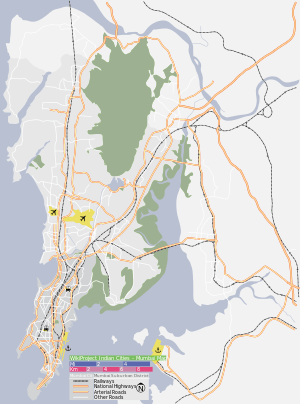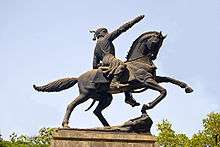Shivaji Park
| Shivaji Park | |
|---|---|
| Urban park | |
|
Young men undergoing Cricket training at Shivaji Park, Mumbai | |
 Shivaji Park | |
| Coordinates: 19°01′36″N 72°50′17″E / 19.026724°N 72.838047°ECoordinates: 19°01′36″N 72°50′17″E / 19.026724°N 72.838047°E | |
| Country | India |
| State | Maharashtra |
| District | Mumbai City |
| Metro | Mumbai |
| Languages | |
| • Official | Marathi |
| Time zone | IST (UTC+5:30) |
| PIN | 400 028 |
| Website |
www |
Shivaji Park is a public park situated in Dadar, Mumbai. It is the largest park in the island city. Like the Azad Maidan and August Kranti Maidan (formerly Gowalia Tank Grounds), it is of historical and cultural value because of the political and social gatherings it has witnessed, both in pre- and post-independence Mumbai. The 112,937 square metres (27.907 acres) open space is renowned as the cradle of Indian cricket.
Geography

The open ground or Maidan is flanked around its edge by a katta, a simple continuous low kerb edging that forms a makeshift seat, a popular hangout for young and old alike.[1] The paved walkway around this perimeter is crowded with people taking walks. The inner circumference of the park is 1.17 kilometres (0.73 mi). The maidan covers 112,937 square metres (27.907 acres), more than half of which is occupied by 31 tenants, the largest being clubs like the Shivaji Park Gymkhana, and the Bengal Club. the remaining part of the ground and open spaces are available to the public for sports and other activities.[2] Other structures dotting the periphery of the grounds include the Samarth Vyayam Mandir (gymnasium), Shivaji Park Nagarik Sangh (established in 1947), a children's Park, Nana-Nani Park ( park for senior citizens), Scout's Pavilion, a Ganesh temple and a library. The walkway is lined with huge rain trees.
The most prominent entrance to the park is the one on the east side, intended only for pedestrians. A bust of Meenatai Thackeray, late wife of Shiv Sena leader Bal Thackeray, has been placed at this entrance. Previously a bust of Ram Ganesh Gadkari was present at the same spot. Bal Thackeray himself was cremated here.[3][4][5]
History

The park was created in 1925 by the Bombay Municipal Corporation, during the British Rule. The ground was known as the Mahim Park till 1927, when it was named after the legendary 17th century warrior king of the region, Chhatrapati Shivaji at the behest of a municipal councillor, Avantika Gohkale.[6] The Shivaji Park Gymkhana, then known as the Dadar Hindu Gymkhana, opened its first Tennis court on the grounds in 1927 and inaugurated its pavilion in November 1931.[7]
Besides being a venue for gatherings of freedom fighters in British India, after independence in 1947, Shivaji Park was the focal point of the Samyukta Maharashtra Chalval (the struggle for a consolidated Maharashtra) that led to the present Maharashtra state being formed in 1960. During this period, the legendary writer, journalist, playwright, poet and social leader Acharya Prahlad Keshav Atre led this movement, addressing crowds of lakhs at this ground, earning him the title of "Lord of Shivaji Park". Shivaji Park has been integral to the political gatherings of the local party Shiv Sena, and has witnessed numerous other political rallies. In May 2010, the Bombay High Court declared the ground as a silence zone after residents filed a Public Interest Litigation (PIL) in September 2009, complaining about the sound pollution in the area on account of the political rallies.[8]
Shivaji Statue

The statue of Shivaji, place on the western side of the park is one of the very few statues in which Shivaji is depicted without having drawn out his sword. Instead, Shivaji is shown simply leading the way with his arm outstretched. Created in 1966 using donations from the local population, the statue is a rare example of the pacifist policies of the then state government of Maharashtra. It was considered a sensitive issue by the government to let this statue depict the usual confrontational posture of Shivaji, who had fought many battles against the Mughal Empire.
Shivaji park and cricket

Shivaji Park maidan is renowned as the cradle of Indian cricket. It is home to eight cricket clubs like those of the late Anna Vaidya and Ramakant Acharekar, which have produced several international cricketers for India. Some famous names who have trained here are Sachin Tendulkar,[9] Sunil Gavaskar, Ajit Wadekar, Suhas Gupte, Vijay Manjrekar, Ramakant Desai, Balu Gupte, M.S. Patil, Dilip Sardesai, Ashok Wadekar, Padmakar Shivalkar, Eknath Solkar, Dilip Vengsarkar, Chandrakant Pandit, Lalchand Rajput, Sandeep Patil, Ajit Agarkar, Pravin Amre, Vinod Kambli and Sanjay Manjrekar. It is a feeder park to Ramnarain Ruia College and Poddar College in nearby Matunga.[10]
Shivaji park and football
Cricket may be the reason Shivaji Park is famous for, but few of the city's budding talent also practice their football here including teams like Adarsh FC, Dadar XI, Dias united Sports Club, Kenkre, BEARS FC, VAKYPPS FC, etc.
Surroundings

The area surrounding the park has many buildings dating back to the mid-1900s, and the Shivaji Park Residential Zone is some of the more sought-after and expensive real estate in Mumbai. This predominantely Marathi neighbourhood is home to many well-known personalities from literature, theatre, commerce and sports.
Some of its prominent residents include are
- Manohar Joshi - Prominent Shiv Sena leader, former Chief Minister of Maharashtra and Lok Sabha Speaker
- Raj Thackeray - Maharashtra Navnirman Sena supremo
- Anup Jalota - Bhajan singer
- Milind Soman - Super model
- Sunil Prabhu - Mayor of Mumbai
- Ajit Agarkar - former Indian cricketer
- Ajit Wadekar - former Indian cricketer and captain
- Sandeep Patil - former Indian cricketer
- Dada Kondke - Film producer
See also
References
- ↑ "Urbanism: What makes Shivaji Park more accessible than Oval Maidan". Firstpost. 21 November 2011. Retrieved 24 September 2014.
- ↑ "BMC: Clubs have taken over half of Shivaji Park". The Times of India. 17 September 2014. Retrieved 24 September 2014.
- ↑ "Shiv Sena chief Bal Thackeray cremated, Uddhav lights funeral pyre".
- ↑ "Bal Thackeray's funeral procession on way to Shivaji Park".
- ↑ "Cremation at Shivaji Park, Time: 5 to 6pm".
- ↑ "The futile row over renaming Shivaji Park". Rediff.com. 12 December 2012. Retrieved 24 September 2014.
- ↑ "Overview". Shivaji Park Gymkhana. Retrieved 24 September 2014.
- ↑ "Mumbai's Shivaji Park declared silence zone". The New Indian Express. 6 May 2010. Retrieved 24 September 2014.
- ↑ "Shivaji Park, Azad Maidan unfazed with Sachin Tendulkar's retirement". Daily News & Analysis. 14 November 2013. Retrieved 24 September 2014.
- ↑ "Mumbai's maidans: Former birthplaces of India's cricket gods". CNN Travel. 1 October 2010. Retrieved 24 September 2014.
External links
| Wikimedia Commons has media related to Shivaji Park. |
- Satellite view of Shivaji Park
- http://www.mumbaikar.com/en/directory/listing/shivaji-park-dadar-w.html
